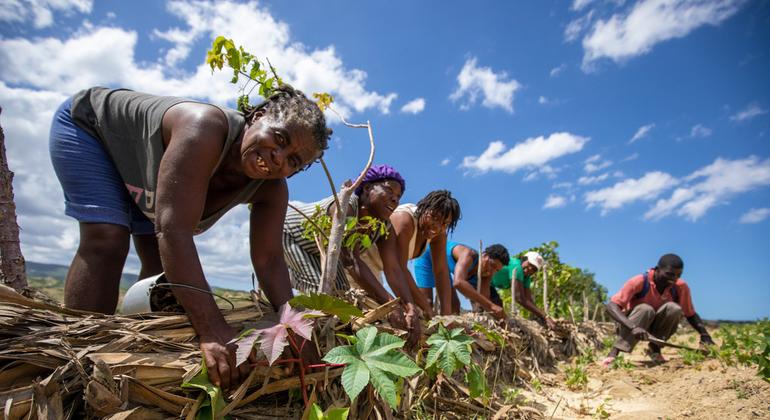“In addition to the triple planetary crisis of climate breakdown, air pollution and biodiversity loss, and the immense suffering caused by the COVID-19 pandemic, conflicts are raging across the world”, said Secretary-General António Guterres.
The ripple effects of the war in Ukraine, are contributing to surging food and energy prices, which are hitting vulnerable developing countries the most”, he added, “but while the problems before us are unprecedented, they are not insurmountable”.
Gloomy forecast
Mr. Guterres painted a grim picture of “unabated and growing” global shocks, and a world economy in which “developing countries are being squeezed dry” as new COVID variants again disrupt lives, throwing “the 2030 Agenda and the Sustainable Development Goals (SDGs) …further off course”.
Meanwhile, the climate catastrophe is “mounting by the day” as global greenhouse gas emissions are “at their highest levels in human history – and rising”.
And the risk of nuclear confrontation is “more acute than it has been for decades”.
“Business as usual will almost certainly guarantee a future of constant crises and devastating risks,” stated the UN chief.
‘Have we woken up?’
The report provides a framework and opportunity to “unite the international community around solutions to this situation,” he said.
“Our Common Agenda was intended as a wake-up call. One year on, we must ask ourselves: have we woken up?”.
It proposes a new global deal to divide up differently power and resources and re-establish social contracts to better manage future shocks and global crises.
The UN chief updated Member States on parts of the Agenda already in motion, including “well advanced” preparations for the Transforming Education Summit in September.
“The largest-ever gathering of learners and teachers will provide an opportunity to mobilize ambition, action, solidarity and solutions; to reimagine education systems fit for the future; and to generate fresh momentum for SDG4 and the 2030 Agenda overall,” said the Secretary-General, noting that the Pre-Summit in June had been “a remarkable success”.
And in September, he will speak about reforming international financial architecture “to tackle historic weaknesses and inequalities,” which will include short-term actions for immediate relief for developing countries, and long-term measures to guarantee resilience.
Agendas for change
The UN’s “five agendas for change” are fostering a “new culture and new capabilities” in the fields of data, digital, innovation, behavioural science, and strategic foresight.
New initiatives are being launched to “unleash the potential of data for people, planet and the SDGs,” he said, pointing to UN Behavioural Science Week that engaged thousands on how to translate scientific method into impacting people and a Futures Lab to strengthen long-term outcomes of programmes.
“Last week the General Assembly adopted a historic resolution declaring the right to a clean, healthy and sustainable environment, demonstrating your commitment to this important goal,” the Secretary-General continued.
Summit of the Future
He spoke in detail about the planned Summit of the Future, describing it as “a once-in-a-generation opportunity to reinvigorate global action, recommit to fundamental principles, and further develop the frameworks of multilateralism so they are fit for the future”.
Human rights and gender equality will be cross-cutting themes, with a consistent focus on a renewed social contract that includes marginalized groups.
“Inclusion of a wide range of voices is not only the right thing to do, but also the only way we will arrive at meaningful solutions,” he said.
Leaders’ Pact
The UN chief hoped that the Summit would yield an inter-governmentally negotiated Leaders’ Pact for the Future to “reinvigorate the multilateral system and make it fit for the challenges of today and tomorrow”.
It should re-focus efforts on existing climate commitments; address international peace and security threats; realize ambitions on human rights, international justice, and gender equality, including safeguarding rights in digital spaces.
“The Pact for the Future must demonstrate to the world that while we face daunting challenges, we can overcome them with co-operation, compromise and global solidarity,” he said.
The Secretary-General set out proposed tracks for and possible outcomes of the Pact, beginning with a New Agenda for Peace to better address “all forms and domains of threats” and prevent the outbreak and escalation of hostilities on land, at sea, in space and in cyberspace.
His second proposal, a Global Digital Compact, seeks an open, free and secure digital future and his third, a Declaration on Future Generations, includes establishing mechanisms to consider their needs as well as a dedicated envoy.
Stopping arms race in space
He hoped that the Summit would yield a high-level political agreement on the peaceful use of outer space, his fourth proposal, including a commitment to negotiate an international instrument to prevent an arms race there.
An emergency platform to manage future global crises in a “fast, coordinated way,” was his fifth proposal, saying the UN was uniquely placed to manage it.
“The world has paid a high price for our ad hoc responses to recent global shocks…No single organization exists to gather stakeholders in the event of such a global crisis”.
Despite the success of the Black Sea Grain Initiative, he stressed: “We do not yet have the mechanisms we need”.
Twin summits
In closing, he drew links between the proposed Summit of the Future, and next year’s SDG Summit in New York, to “rescue the SDGs”.
The twin summits aim to create conditions for a sustainable, inclusive future, which together with the Paris Agreement on climate change, are “our last, best chance to deliver on people’s demand for a multilateral system that manages and solves global challenges in a timely, effective and fair way”.




